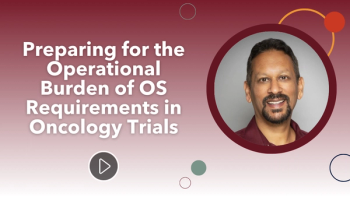
- Applied Clinical Trials-09-01-2007
- Volume 0
- Issue 0
Compassionate Use Guideline Finalized
Industry and patient groups embrace new rules but acknowledge concern over initiative's impact across EU.
The new European procedure for compassionate use of medicines came into effect during the summer. The European Medicines Agency issued a finalized guideline in July on its role in the procedure, after more than five years of discussion. The move has been welcomed by patient groups and by the pharmaceutical industry—although there is a widespread feeling that the new rules do not go far enough.
Peter O'Donnell
The European Cancer Patient Coalition had complained that European Union delay was hurting patients, with compassionate use "an unacceptable lottery" dependent on the measures taken by individual member states. "Many of our cancer patients' lives will depend on whether they can enroll in a clinical trial or are eligible for a compassionate use program," said the Coalition. It acknowledges the merit of the new procedure, but continues to indicate concern over whether it will have sufficient impact.
Similarly, the European Federation of Pharmaceutical Industries and Associations compliments the European authorities on their initiative, but observes: "There is also a need in the longer term for greater harmonization of compassionate use approach and process across member states. The current initiative can hopefully be viewed as a first step towards that long-term objective."
A new possibility
It was the major revision of European pharmaceutical legislation in 20011 that opened up the possibility of compassionate use, as an exception to the general rule that medicines must be authorized before use or limited to use under an approved clinical trial protocol. A compassionate use program with a new treatment still under development became a formal treatment option for patients in the European Union suffering from a disease for which no satisfactory, authorized alternative therapy exists or who cannot enter a clinical trial.
The new guidance makes clear that this facility is in no way intended to replace clinical trials. "From a methodological point of view, clinical trials are practically the only means of obtaining reliable and interpretable efficacy and safety data for a medicinal product," says the Agency firmly. Compassionate use programs may give rise to valuable safety data, but they "cannot replace clinical trials for investigational purposes. Compassionate use is not a substitute for properly conducted trials. Compassionate use should therefore not slow down the implementation or continuation of clinical trials intended to provide essential information relative to the benefit/risk balance of a medicinal product." In addition, "patients should always be considered for inclusion in clinical trials before being offered compassionate use programs."
Although the option is permitted through EU legislation, compassionate use programs are governed by individual member state rules, whether for an individually named patient or for cohorts of patients. The EU role in all of this is to ensure that for medicines covered by the EU's centralized evaluation procedure, a common approach is followed in respect of the criteria and conditions. The European Medicines Agency can issue a non-binding opinion if a member state requests this before making its own decision.
Tight definitions
The rules lay down that the product can be provided only to "patients with a chronically or seriously debilitating disease, or a life threatening disease, and who cannot be treated satisfactorily by an authorized medicinal product" in the European Union. They spell out clearly how these terms should be interpreted. The severity of the disease needs to be justified based on objective and quantifiable medical or epidemiologic data. And while a life-threatening condition "is relatively easily recognizable," defining what conditions are chronic and seriously debilitating must take account of "morbidity that has substantial impact on patients' day-to-day functioning and will progress if left untreated"—such as cancer, HIV/AIDS, neurodegenerative disorders, and auto-immune diseases. "Chronic or serious debilitation or fatal outcome should be a prevalent feature of the target disease," the Agency says.
Even "patients who cannot be treated satisfactorily" is redefined, to designate "patients left without treatment options or patients whose disease does not respond or relapses to available treatments, or for whom the treatments are contraindicated or inadequate." Whether patients can be treated satisfactorily or not will be assessed by the Agency, based on the review of authorized products and on the arguments as to why these are not considered satisfactory.
European Agency opinion
The procedure to be followed is that a member state envisaging making a new medicine available for compassionate use notifies the Agency and indicates if it considers an Agency opinion would be useful. The Agency's Committee for Medicinal Products for Human Use may adopt an opinion that covers the conditions for use, the conditions for distribution, and the patients targeted for compassionate use; and in preparing its opinion, it may request additional data from the company.
In terms of efficacy, the assumptions for compassionate use can be based on mature randomized Phase III trials (in cases where compassionate use and an application for marketing authorization are being assessed in parallel), but acceptable assumptions may also rely on promising early data observed in exploratory trials (such as uncontrolled Phase II trials). In terms of safety, the Agency recommends that all available data should be submitted if it might contribute to refinement of the conditions for use.
The same rules on pharmacovigilance will apply in compassionate use as for any centrally authorized medicine, and the Agency is under an obligation to update opinions on compassionate use on a regular basis or when new data—such as on safety—triggers a review. Once a product has been authorized, updates of compassionate use opinions are, of course, no longer required. The Agency will also keep an up-to-date list on its Web site of the opinions adopted, including member states that have notified it; the names, active substances, dosages, forms, and conditions of use and distribution of products; the target population; and the name and contact details of the company.
GCP inspections rule book
Meanwhile, the Agency has finalized a new book of rules for good clinical practice inspections—or rather, for the European inspectors who have to carry them out. The inelegantly termed "mandate, objectives, and rules of procedure for the GCP Inspectors Working Group" (the Agency has never given way to the temptations of snappy titles!) sets out what it should be doing, and how.
GCP inspectors have been meeting in an ad hoc format at the European level for 10 years now. At the Heads of Medicines Agencies meeting in Lisbon in July 2007, it was decided that this configuration, with its regular quarterly meetings, should henceforward be called the GCP Inspectors Working Group.
Its key role is developing and implementing procedures and processes that promote EU harmonization and mutual recognition of a high standard of GCP inspection. Since EU clinical trial and marketing authorization legislation covers all interventional clinical trials in humans, including both commercially and non-commercially sponsored trials and regardless of whether the active substance used is chemical, biological or herbal in nature, developments concerning GCP at the EU level affect a wide range of stakeholders. Under EU law, an inspection of GCP compliance carried out by one member state is carried out on behalf of the EU as a whole, and the results are recognized by all the member states.
The group develops and agrees on GCP-related guidelines and high-level procedures for the conduct of GCP inspections, dealing with the selection of sites for inspection, and the coordination, preparation, conduct, and reporting of inspections, and any follow-up. It discusses practical implementation of GCP guidelines, common interpretation, and harmonization of GCP inspection approaches. It also maintains close links with the Agency's Pharmacovigilance Working Party, holding meetings specifically on pharmacovigilance inspection every six months, and liaises with the Good Manufacturing Practice Inspection Working Group and other Agency committees and working parties.
Training of inspectors is another of its principal activities, which is seen as crucial to the development of harmonized procedures and practices, along with joint inspections. It shares experience through the review of anonymized inspection reports and findings, and holds discussions on problem issues and case reports.
Meetings are chaired by a representative of the Agency's inspections sector, and its members are drawn from experts nominated by each of the national authorities. The group's rules stress that members should have "senior responsibility for and broad experience in the area of GCP inspections," and that membership implies "a commitment to participate actively" and to attend meetings regularly. The aim is to achieve consensus on issues discussed, but the chair may decide, in exceptional cases, that a vote is necessary.
Each member state has one vote, and an absolute majority is required for a decision, with divergent positions being mentioned in the record of the meeting. The members and any experts co-opted may not have any direct interests in the pharmaceutical industry that could affect their impartiality, and all indirect interests must be entered in a register held by the Agency and accessible to the public.
The group's mandate also allows for it to establish contacts, on an advisory basis, with a wide range of parties concerned with the manufacture and control of medicinal products, and there is explicit provision for the pharmaceutical industry, health care professionals, patients/consumers, and other interested parties to be given the opportunity to comment on regulatory developments.
A date for the diary
This column does not habitually flag upcoming meetings, but an exception is merited on this occasion, on account of the importance of the topic. On October 3, the EU and Agency are organizing a conference on "the operation of the clinical trials directive and perspectives for the future." The declared objective is to provide an overview of the experience to date with the operation of the directive and its implementing texts, to describe its impact and problems encountered, and to offer recommendations for the future.
This promises to be an exciting event, since there are plenty of strongly held views in the clinical trials community across Europe about the topic. The authorities too have been conscious of the need for some serious rethinking about the way the directive is—or isn't—functioning.
So the conference is intended to be a stocktaking among all major stakeholders, and to allow an evaluation of "whether further work on the implementation will provide opportunities to resolve existing problems and whether a revision of the Directive is necessary."
Don't pack your bags yet. As the program says, "attendance at the meeting will be by invitation only." But watch this space.
Peter O'Donnell is a freelance journalist who specializes in European health affairs and is based in Brussels, Belgium.
References
1. Directive 2001/83/EC on the Community code relating to medicinal products for human use (November 6, 2001).
Articles in this issue
about 18 years ago
Global Clinical Trials Activity in the Detailsabout 18 years ago
Monitoring the Monitorsabout 18 years ago
Legislation Expands FDA Oversight, IT Systemsabout 18 years ago
Eyes Wide Openabout 18 years ago
Press One for Safetyabout 18 years ago
A Time for CompassionNewsletter
Stay current in clinical research with Applied Clinical Trials, providing expert insights, regulatory updates, and practical strategies for successful clinical trial design and execution.






.png)



.png)



.png)
.png)
